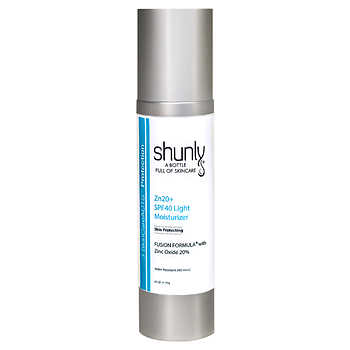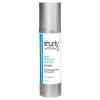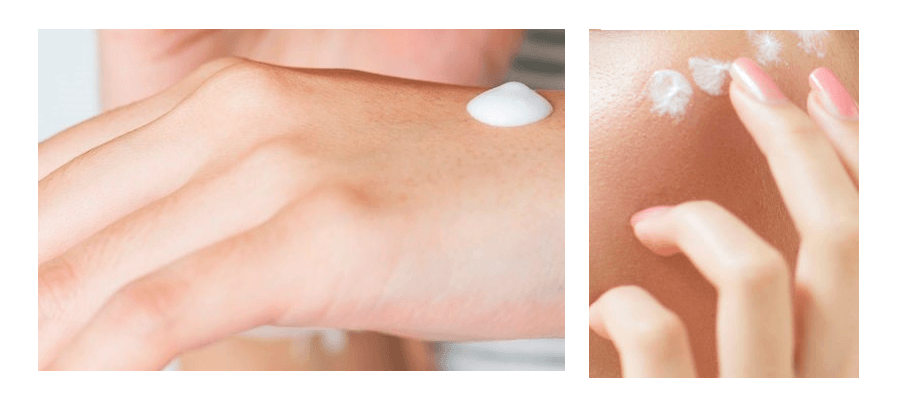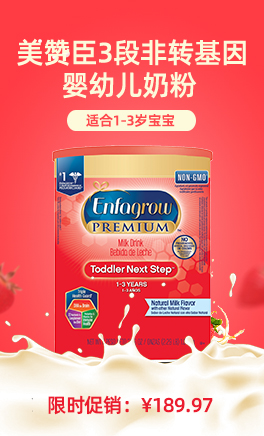
货物源自海外
100%保证正品

55闪购官方国际
物流全程护航

海外商家资质齐全
正品保证

支付宝担保交易
保证资金安全
 |
|
|
| 图片 | 实拍图 | 英文品名 中文名称 |
说明 (说明仅供参考) |
单重(lb) | 单价(¥) | 优惠 | 购买数量 | |
|---|---|---|---|---|---|---|---|---|
 点此看大图,仅供参考 |
Shunly ZN20 + SPF 40 Light Moisturizer, 4 oz. Shunly ZN20 + 轻柔保湿防晒乳 SPF 40 118ml
|
0.4 |
价格:474.43
|
预售充足
|
|
|
|
本站热销商品英文说明Features:
Limit 5 Per Membership
Product details have been supplied by the Manufacturer, and are hosted by a third party. Zn20 + SPF40 Light Moisturizer Technologically advanced formula for the prevention of sun-induced breakdown of the collagen matrix – known as matrix metalloprotease (MMP) - one of the primary causes in the development of lines and wrinkles. This lightweight, transparent, fragrance-free formula is designed for even the most sensitive skin types as it utilizes our #1 rated physical sunscreen filters to help defend skin against free radical production, prevent collagen breakdown and premature aging of the skin. This single sunscreen filter offers a soft, silky and elegant texture that absorbs quickly while providing super photo protection. PROBLEM: Long-term exposure to UV-A and UV-B rays contributes to the production of toxic free radicals, which ultimately damage collagen - the leading cause of premature aging and wrinkling of the skin. SOLUTION: To promote anti-oxidant activity within the skin. Shunly? Skin Care Zn20+SPF40 Light Moisturizer contain 20% Zinc Oxide specific ingredients that defend against free radical production, prevent collagen breakdown and premature aging of the skin. BENEFITS
ACTIVE INGREDIENT: 20 % Zinc Oxide How to apply Apply generously to cleansed, toned and hydrated skin, pay special attention to sun exposed areas and Re-apply if active, sweaty, or after swimming. For optimal results use together with Shunly antioxidant vitamin B,C,E + Ferulic Treatment to helps neutralize free radicals and maximum sun protection.

Zinc Oxide - #1 Rated Physical Sunscreen Filter (280 nm - 400 nm) To reinforce the powerful UV barricade and achieve the SPF40 rating, multiple particle sizes of 20% Zinc Oxide tested ingredients are among the most effective and renowned majority of UVA-I + II & UVB radiation. Zinc Oxide is a natural pigmented mineral with great astringent properties that has been used topically for centuries as a skin protectant and wound healing adjuvant. It is recognized mild antimicrobial agent as well as reflects infrared from the skin. The ability to protect in the long UVA range is much higher than other sunscreen ingredients that sits on top of the skin as opposed to being absorbed into the skin, this allows it to screen both UVA-I, UVA-II, and UVB rays of ultraviolet light. Because it resides on the surface of the skin, it won’t irritate the user or produce any allergic reaction. This antioxidant enriched ultra-sensitive creamy base sunscreen is safe and easy to apply. It's ideal for all skin types including acne, rosacea and eczema skin conditions to soothe, calm and protect the skin. It goes on evenly and comfortably to create a gorgeous appearance by smoothing out the complexion of your skin tone. Physical VS Chemical Sunscreen - How it work! Physical sunscreens ("In-Organic Sunscreen"): Protect skin from the sun by deflecting and blocking the sun rays. It doesn't cause free radicals, irritate or produce any allergic reaction to the skin. Start protecting immediately upon application. Three important photoprotective physical blockers are Zinc Oxide, Titanium Dioxide, and Iron Oxides. Chemical Sunscreen Filter ("Organic Sunscreen"): Protect the skin by absorbing the sun rays into the skin where they in turn absorb portions of the light spectrum. Must wait 20 minutes after application for effective sun protection. The most common chemical absorber sunscreens are OctylSalicylate, OctylDimethyl (Paba), Octinoxate, Meradimate, Oxybenzone, Octocrylene, Avobenzone, and Homosalate. Sunlights Spectrum in Nanometers (nm) & Radiation Ultraviolet C (UVC) - (100-280 nm) - shortest wavelengths UV rays that can photo damaging to the skin, results in the skin burn with exposure. UVC generated by the sun is screened from reaching us by the protective ozone layer. Ultraviolet B (UVB) - (280-320 nm) - intermediate wavelength of ultraviolet rays and causes the initial appearance of erythema, commonly called "Sunburn": usually perceived as redness. It primarily damages the epidermis (the outermost layer of the skin). The superficial redness and painful irritation caused by UVB subsides after a relatively short period of time, but the underlying damage remains and accumulates, potentially resulting in basal cell and squamous cell cancers. Excessive exposure to UVB is the foremost promoter of premature aging of the skin. Some indoor tanning devices also emit UVB. In addition to staying out of the sun between 10 a.m. and 4 p.m. when UV rays are strongest, you can protect UVB by applying sunscreen, wearing protective clothing, sunglasses, and avoiding tanning devices. Ultraviolet A (UVA) - (320-400 nm) - UVA are the longest of the ultraviolet wavelengths. While energy from the shorter UVB wavelength is absorbed in greater amounts in the epidermis and in keratinocyte DNA, energy from UVA penetrates more deeply into the dermis. In addition to skin darkening (tanning), UVA-induced photodamage, usually seen as dryness, uneven pigmentation, inflammation, fine wrinkles and skin cancer. Even a low dose of UVA can cause photodamage leading to wrinkles and sagging skin. UVA adversely affects the deep dermis resulting in a loss of the elastic quality of its supportive collagen, causing premature aging. UVA represents 90-95% of terrestrial UV radiation. Unlike the shorter UVB wavelengths, UVA easily penetrates window glass and retains essentially the same energy level all day long, every day of the year, presenting the same damaging effects at 9 a.m. in December as it dies at the 4 p.m. in July. As with UVB, we can protect ourselves against UVA by staying out of the sun, applying sunscreen, wearing protective clothing and sunglasses, and avoiding indoor tanning devices. Use products that address this wavelength specify "UVA protection" or "Broad-Spectrum Protection" on the label. However, "Broad-Spectrum Protection" is not total spectrum protection, and safely maintaining unaltered essential biological functions can only be achieved by well-balanced, photostable sunscreens that protect against the entire spectrum of UV radiation. Unfortunately, there is presently no standardized indicator, numerical or otherwise, to signify the level of protection against UVA, but sunscreens containing Zinc Oxide and Titanium Dioxide will protect against UVA radiation. Light Spectrum in nanometers (nm) with Physical & Chemical Sunscreen Filter Physical Blockers:
Chemical Absorbers:

What is Ultraviolet (UV) Light? UV light is radiation energy in the form of invisible light waves. UV light is emitted by both the sun and by tanning lamps. 
How Does UV Affect the Skin? UVC (100-280 nm)-Shortest UV rays that can photo damaging to the skin resulting in skin burn. UVB (280-320 nm)-The intermediate wavelength of UV rays commonly call "sunburn", primarily damages the epidermis. UVA (320-400 nm)-The longest wavelengths penetrates deeply into the dermis can cause pigmentation, inflammation, fine wrinkles, dryness, and skin cancer. 
Physical VS Chemical Sunscreens Physical SPF (Inorganic sunscreen) Application effective time: Immediately upon application. Three phyto-protective blockers are titanium dioxide, zinc oxide, and iron oxides. Chemical SPF (Organic sunscreen) - Application effective time: Must wait 20 min after application for effective sun protection. 
Choosing a Formula UVB rays are known to cause sunburn and skin cancer, they do not penetrate the skin as deeply as UVA rays. UVA rays have been proven to cause skin cancer & skin aging. It is important to choose a sunscreen that protects against a wide range of ultraviolet light. Look for the active ingredients listed with physical filter and use together with antioxidant vitamin C, E, and coenzyme Q10 to help neutralize the free radicals. FREQUENTLY ASKED QUESTIONS What SPF rating I should look for? The SPF rating assigned to a sun protection product is an indicator of its ability to protect against the UVB wavelength of light and is determined based on acute erythemal reaction, i.e. sunburn. Choosing sun protection based solely on SPF is not enough. The common rule of thumb to "use SPF 30 or above" to protect the skin from sun damage is outdated, misleading and can be dangerous. SPF rating pertains to UVB radiation only. UVB is not the only ultraviolet wavelength that damages the skin. SPF is not a sufficient or reliable indicator of the level of protection against any biological damage other than sunburn. As our understanding of light`s impact on skin has evolved, it has become clear that UVA adversely affects the deep dermis far more than the superficial "sunburn" caused by UVB rays, and we suggest that pay attention to active ingredients listing on the label containing Zinc Oxide and Titanium Dioxide will protect against broad-spectrum UVA & UVB radiation. How can I tan without burning? There is no such thing as a "safe" tan. Chronic exposure to the sun causes long-term problems including cancer. One in five Americans will develop skin cancer in their lifetime as a result of too much sun exposure. Some people believe that indoor tanning is a safer alternative to the sun, however, the study reveals that users of indoor tanning devices actually have a higher risk of developing melanoma than non-users. What are free radicals? Free radicals are highly reactive molecules that attack cells and damage collagen and elastin. They are triggered by pollution, sun, stress, smoke, oxygen, even the body`s own processes. Free radicals are believed to be partly responsible for again skin through a process called oxidation. A free radical, known as reactive oxygen species, attacks another molecule and steals an electron from it, setting off a chain reaction of free radical damage to cells. The free radical chain reactions that may overwhelm the natural antioxidant structured, consequently leading to the destruction of vitamin A,C,E, and other molecules. An antioxidant is a molecule that helps neutralize free radicals and protects skin by helping to block damaging reactions to skin cells. If the skin is rich in antioxidants then the levels of vitamin remain normal and the network antioxidants such as vitamin C & E, coenzyme Q10, recycle each other back into activity. This is why it is equally important to use with Shunly antioxidant vitamin C serum (B,C,E + Ferulic Treatment) to prevent and slow down the process of photo-aging. What’s so special about Zn20+ SPF40 Light Moisturizer? This powerful Physical SPF contains as much as 20% of Zinc Oxide that is among the most effective and renowned actives delivering high levels of UVA-I & II & UVB protection. Zinc Oxide has been used topically as a skin protectant and wound healing agent for centuries. It is recognized as a mild antimicrobial agent that also has the ability to reflect infrared rays from the skin so it's not being absorbed into the skin as opposed to other sunscreen filters. Since Zinc Oxide resides on the surface, it doesn't irritate or produce any allergic reaction to the skin. On top of its active formula, this product's delicate creamy base makes it easy to apply, which is appreciated by those with Acne, rosacea and eczema skin condition. What is ultraviolet (UV) light? UV light is the radiation energy in the form of invisible light waves that is being emitted by both the sun and by tanning lamps. The sun discharges three types of ultraviolet radiation: ultraviolet A (UVA), ultraviolet B (UVB), and ultraviolet C (UVC). The UVC does not penetrate the upper atmosphere while UVA and UVB reach the earth. Research has shown UVB/UVA may cause skin damage. Tanning lamps also produce UVA and /or UVB. These artificial rays affect the skin in the same way as UVA and UVB from the sun. What's the difference between UVA & UVB action on the skin? Ultraviolet A (UVA) rays are deeply penetrating skin aging rays that:
Ultraviolet B (UVB) rays are the sunburn rays that:
Are some sunscreen ingredients more effective than others? Yes! Zinc Oxide and Titanium Dioxide. These two physical sunscreens are generally more effective than the others as they physically block out sun rays. They also provide protection by remaining on the skin and reflecting and refracting light. In contrast, chemical sunscreens are absorbed into the skin where they, in turn, absorb portions of the light spectrum. Physical sunscreens protect against a broad range of UVA and UVB light, are not harmful to the skin and are more effective than chemical sunscreen filters, which can break down in the sun. It depends upon the product. Check the label to make sure it blocks both UVA/UVB radiation. For best results, look for Zinc Oxide and Titanium Dioxide in the list of active ingredients. Zn20+SPF40 Light Moisturizer offers sunscreen filters against both UVA-I & II / UVB for all skin types, including ultra-sensitive skin such as acne, eczema, and rosacea. How can I incorporate Zn20 + SPF40 Light Moisturizer into my existing skincare regimen? Your eyes and neck are the focal points of the face and the one feature we most associate with personal identity. While repeated exposure to UV radiation results in premature aging of these areas, which encompasses a number of signs that reflect structural changes in the dermis. Documented research studies conclude proper antioxidant protection can visibly improve, protect, and reduce signs of photo damage to the skin. It is equally important to use with Shunly antioxidant vitamin C serum to prevent and slow down the process of photo-aging. Do I have to protect my skin if I spend most of my day in the office?
Absolutely! The minute you walk out from your house to the car, while you are driving, stop at the Starbucks for coffee, the walk from the car to office building, time to get your lunch from store, left the office to the car and drive to heading home while the sun still rise on summer time etc.. Do I have to use SPF in winter when there is no sun out?
Regardless of the season, hyperpigmentation, dark spots can get darker while redness can get worse. Therefore it is necessary to protect the skin from sunlight and repair damages already done due to sun exposure. Most of us don't realize the winter environmental light can be damaging to our skin cells and promote hyperpigmentation and dark spots as much as in summer time. UVA rays stay the same, all day, everyday, and all year long. |




